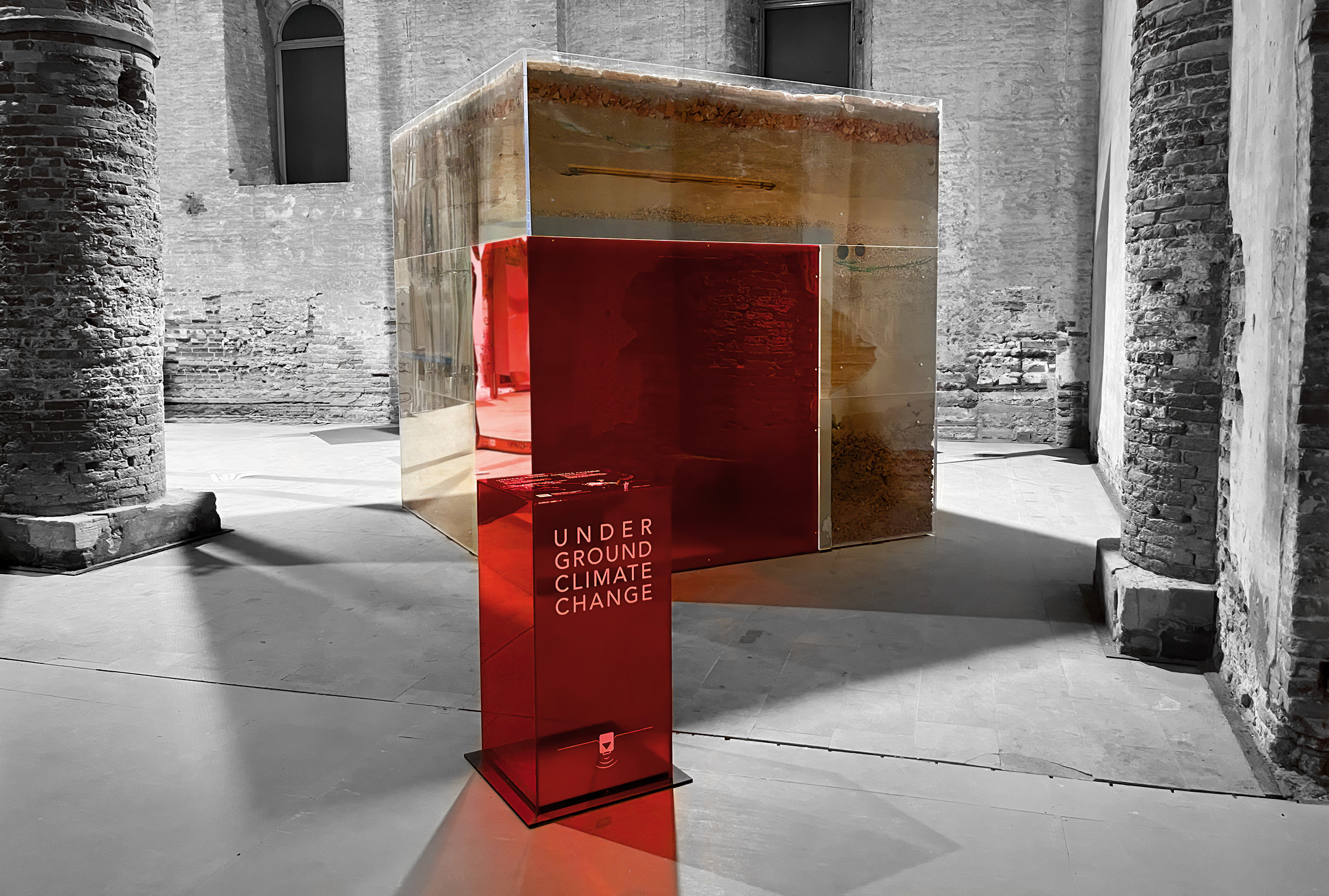BIENNALE ARCHITETTURA 2025
As part of the 19th International Architecture Exhibition of La Biennale di Venezia, our team unveils a striking installation that brings underground climate change—an invisible yet global phenomenon—into plain view. Inspired by the raw materiality of Land Art, this piece transforms a 3x3x3 meter volume into a full-scale extrusion of the urban underground.
Within this sculptural cross-section, a dense network of buried infrastructure—building basements, sewer lines, district heating systems, and more—reveals the hidden drivers of rising subsurface temperatures in cities around the world. It’s a glimpse into a space we rarely see—one that is silently warming, yet holds enormous untapped potential.
CIRCULARITY AND SUSTAINABILITY
Sometimes, the best impact is no impact. With this philosophy in mind, we made every effort to minimize the environmental footprint of our project while fostering circularity and sustainability. Essentially, within a 3m x 3m footprint, there are three editions of the Biennale, pieces of its walls, and decades of dedication and actions from the project team to address climate change and social justice. Learn more about our approach to circularity and sustainability here.

Sensor
Gas pipe
Soft clay
Fill
Sewage pipes
Underground cables
Stiff clay
Hard clay
The architectural installation of the project Underground Climate Change at Biennale Architettura 2025.
The installation represents an extrusion of the urban underground with a slice of a subterranean structure (building basement, underground parking, pedway, mall, or other underground space) and other drivers of underground climate change, including pipes and conduits.
PHENOMENON
Beneath urban areas lies a hidden world of infrastructure—parking garages, tunnels, basements, even entire buildings. But all this underground infrastructure generates heat, and over the years, such heat has been slowly leaking into the ground. The result? A rising phenomenon called underground climate change.
In some urban areas, underground temperatures are climbing by up to 2.5°C per decade, with hotspots reaching about 70°C. That’s hotter than a summer day in the desert—right below our feet. These extreme subsurface temperatures threaten the durability of civil infrastructure, the operation of underground transit systems, the comfort and health of people using underground public transport, and the resilience of subsurface ecosystems.
But here is the twist: this challenge also opens up powerful opportunities. It pushes us to retrofit old buildings and infrastructure with smarter, greener solutions—and gives us a compelling reason to use shallow geothermal technologies to turn waste heat into a valuable resource for warming the very places we live and work.
SENSING BELOW
As a part of this project, we have transformed the cities of Lausanne (Switzerland), Chicago (USA), Boston (USA), and Venice (Italy) into living laboratories, deploying hundreds of wireless temperature sensors above and below the ground––from building basements to tunnels, underground parking garages, parks, the ground, and water.
These networks enable to monitor underground climate change and turn data into actionable knowledge, paving the way for mitigation strategies through an analysis and prediction of the influences of this phenomenon. If you are walking through Lausanne, Chicago, Boston, or Venice, keep an eye out—you might spot a sensor nearby.
THE LIVING LABORATORIES
THE LIVING LABORATORIES
In 2018, we transformed multiple building basements across Lausanne, Switzerland, into sensory environments. The goal was to explore how much heat is wasted in the ground beneath the city. The results indicate that each year, an amount of thermal energy equivalent to the annual consumption of 7,000 buildings is wasted in the city’s subsurface.
LAUSANNE, SWITZERLAND
In 2019, we equipped multiple building basements, underground parking garages, tunnels, and subterranean streets across Chicago with sensors. The goal was to understand how waste heat deforms the ground beneath the city and its foundations.The results indicate that the infrastructure supporting Chicago—like that of many other cities worldwide—is shifting due to underground climate change.
CHICAGO, USA
BOSTON, USA
VENICE, ITALY
PROJECT TEAM
Team Members
Alessandro F. Rotta Loria
Giorgia Chinazzo
Margaux Peltier
Melissa Rotta Loria
Guido Corino
Andrea Mangiantini
Anjali Thota
Zhonghao Chu
Elena Ravera
Beatrice Formenti
Anaëlle Burnand
Supporters
The Alumnae of Northwestern University
Rebiennale
ela INNOVATION
Must Be
MODOLAB
Service de la Promotion de l’économie et de l’innovation – Canton de Vaud, Suisse
Università Ca’ Foscari Venezia
Marine Archaeology Research Venice Equipe
Club Subacqueo San Marco
Jolly Snc
Orto del Campanile
Giuseppe Piccolo Architetto
Milestone Architecture
InParadiso Art Gallery – Concilio Europeo dell’Arte
